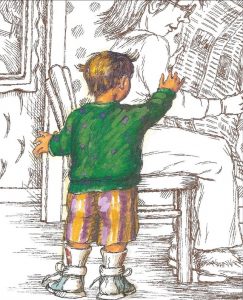By Clara Keane | July 6, 2017 | Children
Giora Carmi, MA, ATR-BC, LCAT is an art therapist and illustrator of children’s books and other genres. The AATA interviewed him about his experience working with children both as clients in art therapy and as consumers of children’s books. In the following interview, Carmi discussed his book Circle of Friends (Carmi, 2003) in the context of how children can learn empathy through imagery and shared his experiences working with children in art therapy.
 Carmi’s successful career in illustration ultimately led to becoming an art therapist. He worked as a graphic designer in Israel for fourteen years, during which time he illustrated over two hundred book covers and fifteen children’s books. After moving to the U.S. in 1985, Carmi worked as an illustrator for the New York Times and the Wall Street Journal and illustrated forty-two children’s books including two that he wrote himself. In 2004, he earned his degree in art therapy from NYU and now works as an art therapist in New York City.
Carmi’s successful career in illustration ultimately led to becoming an art therapist. He worked as a graphic designer in Israel for fourteen years, during which time he illustrated over two hundred book covers and fifteen children’s books. After moving to the U.S. in 1985, Carmi worked as an illustrator for the New York Times and the Wall Street Journal and illustrated forty-two children’s books including two that he wrote himself. In 2004, he earned his degree in art therapy from NYU and now works as an art therapist in New York City.
How Children Can Benefit from Viewing Images
His book Circle of Friends is particularly unique because it includes only illustrations, which enhances the viewer’s experience by freeing the imagination. The premise of the story is a continuum of kind deeds. A boy asks his mother for money to buy a muffin, which he places on a park bench beside a sleeping homeless man, who wakes up to the gift. The man shares crumbs with two birds that feed them to a fledgling. Later, the little bird flies down from its nest, takes a seed from the outstretched palm of the man, and deposits it in the window box of the boy’s house. The seed grows into a beautiful sunflower.
When asked why he chose to make the story wordless, Carmi says that he wanted to offer his audience the opportunity to interpret the story personally, free of anyone else’s analysis. He explains, “We are attached to words like they are the best things out there – in a way, they are [great]. But, through art, there is a way to communicate on a deeper level.” He continues, “Most of our thinking is a linear process, but if we expand what we do with our mind, we open ourselves up to many layers of thought and can follow more than one thread at a time.” This is creativity. Carmi offers the analogy of driving, stating that many people love to drive but can’t quite verbalize why. He explains that when driving, one cannot limit the focus to one thing. One has to focus on the road and simultaneously pay some attention to all other surroundings. If asked, a driver may say he just minds the road, when in reality he is automatically giving attention to the many other things around him and maintaining multiple levels of focus. Carmi calls this, “a deeper state, in which we feel really good.”
Carmi believes that parents and educators, by offering necessary structure, often also limit children’s imagination by emphasizing only linear thinking. Children’s minds are not yet restricted to conventional or linear thinking. Carmi hopes that his book will allow children to interpret his story in their own, richer way, not only following suggestions by text under images. He recounts a story of when his book was initially rejected for publication. Carmi decided to take the book to children and see how they would tell the story.
Carmi printed poster-sized images of the illustrations and brought them into classrooms. He instructed the children simply to “tell me the story.” The children would jump out of their seats and spontaneously tell the story “beautifully and emotionally,” he recalls. Carmi maintains that those children told the story better than any reviewer has to date. There was nothing holding the children back from diving deep into issues about homelessness and reflections on how they could incorporate sharing into their daily lives. This is what deeper thinking does, he says.
How Children Can Benefit From Art Therapy
In addition to discussing how Carmi creates images for children’s viewing, we asked him to reflect on his experience as an art therapist, working with children in the art making process. He contrasts the difference between working with children and adults which is primarily based on the level of their spontaneity. He works from the premise that while adults can reach a deep level of thinking and self-reflection, it often takes a few sessions. With children, however, this space is reached much more easily, because children are in a deeper state all the time. Carmi explains that “because children are in a deeper level of thinking beyond the ‘us versus them’ mentality and even their trauma a child can still change her behavior relatively easily.” He believes that this deeper level can be reached through art making. This is where the power of art therapy comes into play. When children paint difficult feelings (anger, envy, fear, etc.), they can – by being in a deeper, creative level of thinking – look at their psychological state; this can soothe them so that eventually those feelings no longer have the same level of control over their lives.
Thus, art therapy provides children with more freedom to be themselves. Carmi believes that art therapy and the creative process also help children to become more empathetic, to move beyond the “us versus them” kind of thinking. He adds, “It is the sweetest thing when children create. They become more interested, calm, and focused. Nothing is more beautiful.”
In conclusion, Carmi expressed his concerns regarding the federal budget proposal that had suggested eliminating the National Endowment for the Arts. This proposed cut, coupled with schools curtailing their arts program, he believes is the opposite of what schools and communities should be doing. He said, “If you want to make students happy, expose them to art. Through this, they will be the best citizens and innovators.”
All images are displayed with permission from Giora Carmi.
References:
Carmi, G. (2003) Circle of Friends. New York, NY: Star Bright Books.



